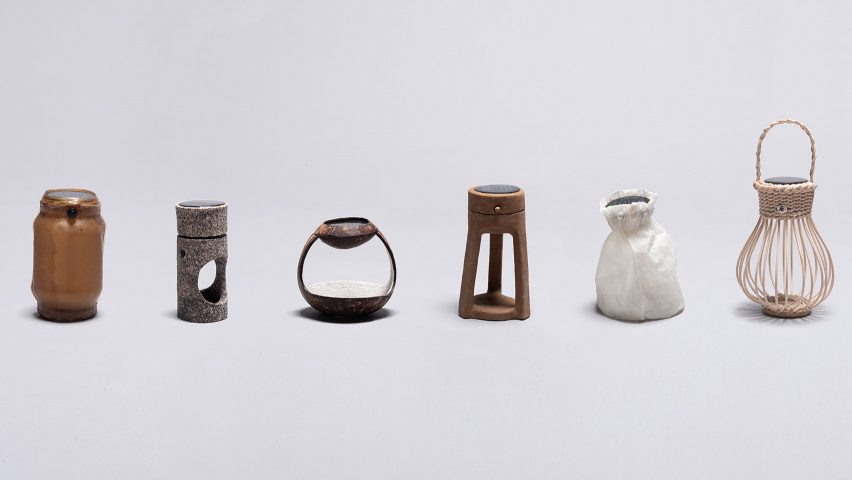Six students from the Instituto Tecnológico de Monterrey in Mexico have designed low-cost solar lamps made from mud, beans and cactus slime for people living in isolated rural areas with limited electricity.
Led by Moisés Hernández, the Solar project saw six students develop six different lamps made from waste materials found in rural Mexico, such as wicker, coconut bark and the maguey pulquero plant.
Using solar cells and LED technology, the lamps propose a sustainable solution to the need of nearly seven million Mexicans that live in isolated rural areas with limited or no access to electricity.
Taking cues from the solar-powered Little Sun lamp by Icelandic artist Olafur Eliasson, Hernández and his students aimed to create lights with the lowest possible carbon footprint using bio-materials and low-cost manufacturing methods.
While some of the chosen materials will not last as long as Eliasson's plastic Little Sun, Hernández told Dezeen, the goal of the project was to design lamps with bodies that can be easily produced using local materials.
This way, people would need just the simple electronic components and the solar panel. The main structure could be fixed or replaced by making another from materials found in the surrounding environment.
"What we intend with this project is to look for new ways of production in rural areas or isolated communities where they do not have any injection plastic facilities to make the main bodies of lamps," Hernández explained.
"With these new material ideas that came from different sites across Mexico, where the weather and context are so different, the students visualised new scenarios where these type of technological objects can be assembled and distributed to local people."
The Adobe solar lamp by Luis Fernando Sánchez Barrios is built from mud, recycled paper and cactus slime – a mixture that the designer says offers a substance similar to cooked clay.
Designed for marginal communities that are dispersed throughout Mexico, Barrios' lamp references "pre-hispanic knowledge" of materials as well as an environmental awareness.
Oscar Andrés Méndez Hernández looked to the black bean when considering natural materials for his solar lamp, which is designed to provide light on a worktable.
The LED sits above a circular cut-out in the centre of the structure, allowing the user to appreciate the texture and colours of the material as the light shines on its surface.
A coconut shell was used to form the body of Rafael Sánchez Brizuela's lamp, while animal tissue waste – also known as collagen – that has been pulverised and injection moulded was used to create Naoto Ricardo Kobayashi Utsumoto's translucent, brown-hued lamp.
Viridiana Palma Dominguez made the body of her lamp from the cuticle and skin of the maguey pulquero plant – the contents of which is used to make an alcoholic drink called pulque.
Aniela Mayte Guerrero Hernández, on the other hand, looked to more traditional materials, using handmade wicker by craftsmen in Tequisquiapan, Queretaro, a region located in the centre of Mexico.
Hernández and his group of students are just some of many designers who seek out unusual materials to make more interesting and sustainable products.
Other creations include a fashion collection made from seaweed, lighting made from discarded cow intestines and tableware made from out-of-date eggs.

